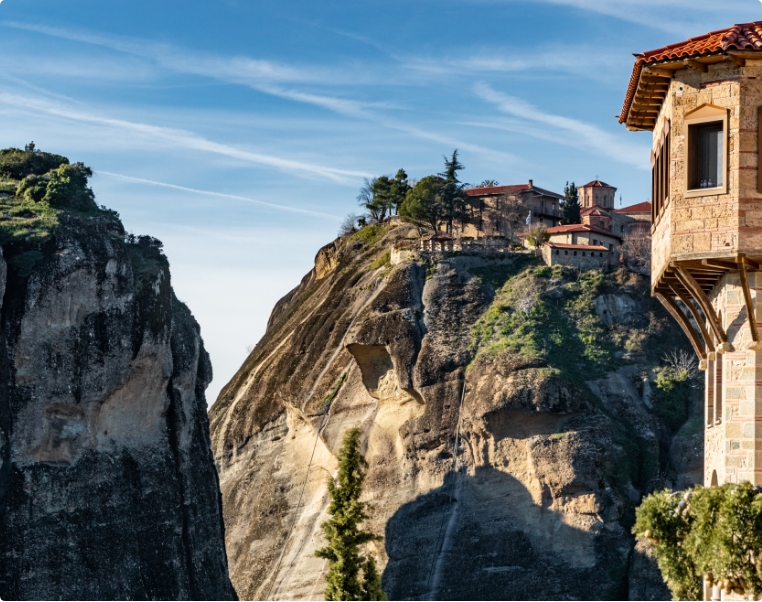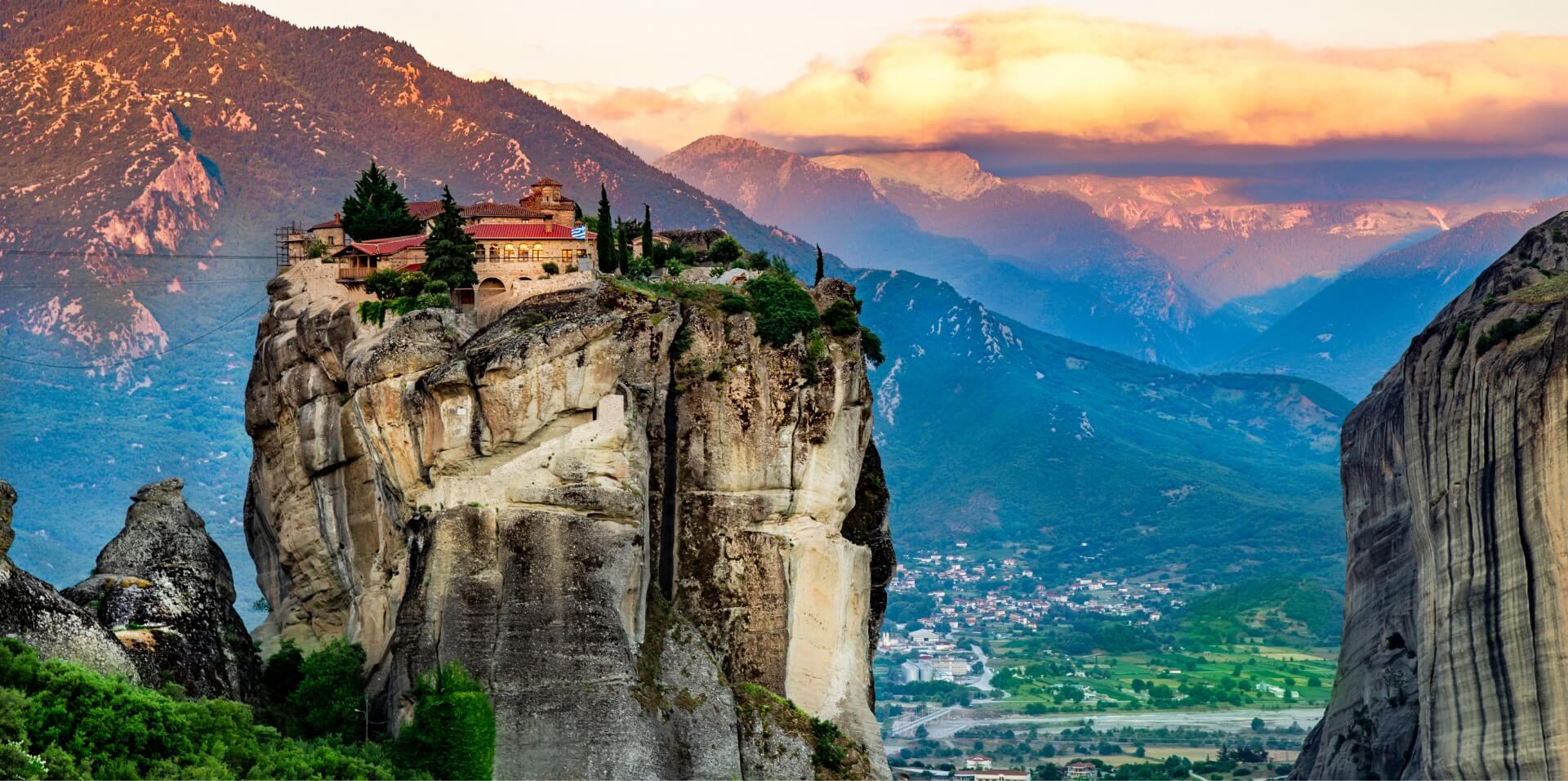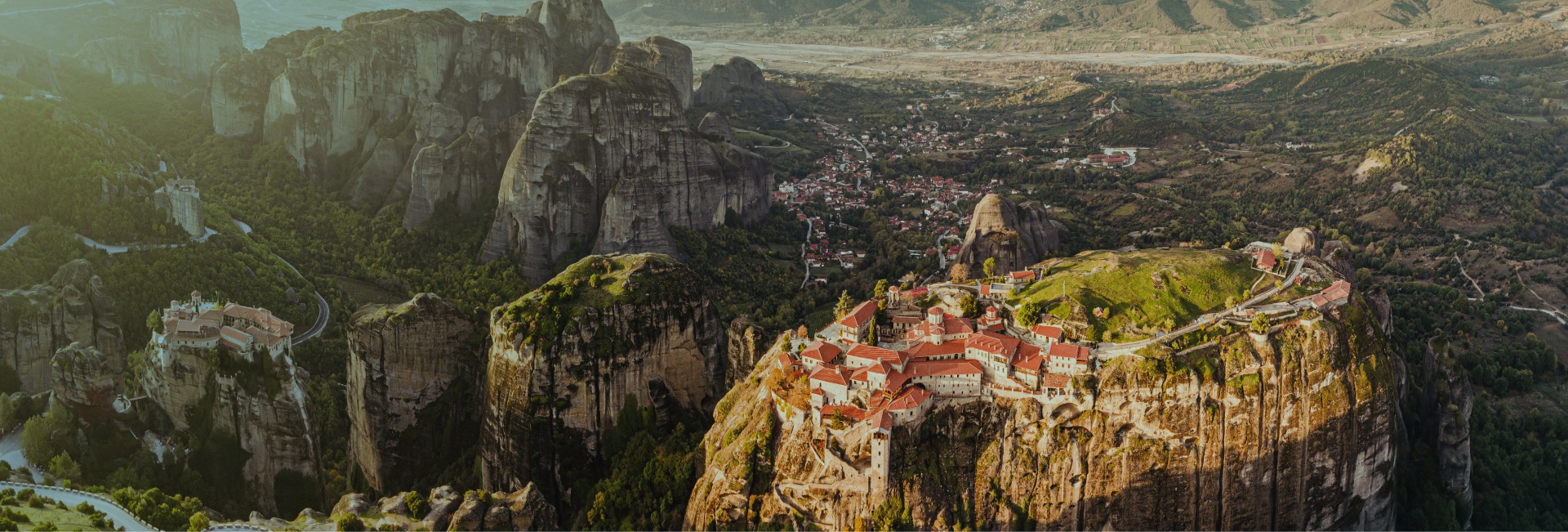Meteora – Kalambaka Tour
From: 74,00 €
Meteora
The imposing rocks of Meteora constitute the most awe-inspiring site at the area of Kalambaka and nearby locations: the greatness of nature, revealing a unique – in Greece – geological phenomenon. Meteora is also one of the most important historical sites of the Greek Orthodox Church, where the monasteries are clinging for centuries to these steep rocks, declared by UNESCO a World Heritage Site.
Meteora is the most amazing base for exploring nature and its endless beauty along with realizing the need of people to meet God in order to develop serenity and mental calm.
Departure Dates
Every Monday, Wednesday, Friday & Sunday From the 1st of April 2024 until 31st of October 2024Meeting point & Departure time
08:00, “Statue of Venizelos” Aristotelous Square & Egnatia streetTour Duration
approximately 11 hoursTour Description

Thessaloniki - Meteora
We depart to Meteora with the luxurious bus of “Tsokas Travel” along with our English- speaking trip attendant, at:
– 08:00 from the “Statue of Venizelos” Aristotelous Square & Egnatia street
The distance is 230km and lasts approximately 3 hours (one way) and there is a 20’ stop for rest and coffee.
We reach Meteora at around 12:30p.m; …
… the place where you can witness the human will to reach the sky… to reach divine… to reach God…
… the huge “forest” of massive Paleolithic stones and the blooming nature, compose a breathtaking scenery …
… the 6 monasteries built on the peaks of them …
- the women’s monastery of “Saint Stefanos” with the unique wood-carved works of art, such as the gold-embroidered iconostasis of the Saint Stephen Church, the Episcopal throne decorated with marble and ivory and the baldachin which covers the Altar, on which there is the holy skull of Saint Charalambus,
- the monastery of “Agia Triada” (Holy Trinity) in which the visitors are led to, after they have passed a narrow path at the bottom of the rock and ascending 140 -hewed on the steep rock- steps,
- the women’s monastery of “Rousanou” with the distinguished depictions of stylites, hermits, scenes of Saints martyrdom and the impressive many-faced compositions on the narthex that depict the Second Coming and the Judgment,
- the “Varlaam” monastery that saves a rich and important collection of about 300 manuscripts, the almost 600 years old wooden barrel with a capacity of 12 tons and the characteristic surviving frescos of the 1548.
- the monastery “Metamorphosis Sotiros” (Transfiguration of Jesus Christ), which is the oldest, the most significant and also the largest monastery of Meteora, builded around 1340,
- the monastery of Saint Nicholas Anapafsas, decorated with the beautiful frescoes of the famous painter Theophanes Strelitzas from Crete, that exceed all expectations.
We will see all 6 monasteries and visit 2 of them. Every:
- Monday: we visit the Holy monasteries of Varlaam and Rousanou,
- Wednesday: we visit the Holy monasteries of Saint Stefanos and Varlaam,
- Friday we visit the Holy monasteries of Rousanou and Saint Stefanos,
- Sunday: we visit the Holy monasteries of Saint Stefanos and Varlaam.
Later on, enjoying the enchanting landscape of the wider area of “Kalampaka” we will head to the village “Kastraki”, where you can comfortably browse and do your shopping in the shops with the Holy pictures and the local traditional products or to enjoy the local cuisine in one of the traditional taverns overlooking the imposing “Meteora”.
Full of images of unparalleled natural beauty and having lived a unique experience, around 16:00 we depart for Thessaloniki and the points from where we pick you up.

Kalambaka - Kastraki
During our tour we will have the chance to admire all six monasteries, but we will visit only two of them, depending on their opening hours, according to which every:
- ⦁ Monday we visit the Monasteries of “Roussanou” and “Varlaam”.
- ⦁ Wednesday & Sunday we visit the “Convent of St.Stephen” and “Varlaam Monastery”.
- ⦁ Friday we visit the “Monastery of Roussanou” and the “Convent of St. Stephen”.
Then, enjoying the magical scenery of the area of “Kalambaka”, we will head to the village of “Kastraki”, where you can enjoy the unique shopping opportunities offered at shops which sell local products and holy icons or savor the taste of the local cuisine at one of the traditional taverns, offering great views to “Meteora”.
Being full of enthusiasm with the beautiful scenery of unparalleled beauty and having enjoyed a unique experience we will leave at 16:00, getting you to the points of departure in Thessaloniki.
Included in price
- Transportation by luxur air-conditioned bus.
- English speaking trip attendant.
- Pick up/drop off service.
- All taxes.
- Full insurance coverage for passengers on the bus.
- FREE tickets for open-top sightseeing bus tours of the company “City Sightseeing Thessaloniki” (Hop on-hop off tour)
Additional services
- FREE passengers’ tips.
Not Included
- Entrance fees (3 Euro per person/per monastery), only cash.
- Guide.
- Personal Expenses & Gratuities (optional).
- Lunch (optional) in a traditional tavern in traditional village of Kastraki Kalabaka.
Useful Info
- You will meet our staff members at the point of departure/arrival “White Tower” (Lefkos Pyrgos) and our tour leader on the bus.
- You are recommended to have contact with the tour leader and comply with the guidelines for avoiding misunderstanding.
- Try to arrive at your desired point of departure at least 10 minutes prior to the time referred to in the timetable.
- The Meteora monasteries have strict dress codes so you have to keep your knees and shoulders covered (no trousers, short or sleeveless tops are allowed).
- Get information on weather conditions.
- Dress casually with casual footwear. Do not forget your hat, sunglasses and sun cream (in summer).
- We wish that you enjoy the tour to the fullest and do not forget…
- ….take the most amazing photos and… share this tour experience with us and your friends…
More Services & Offers:
- FOR FREE rain ponchos
- FOR FREE tips for passengers








